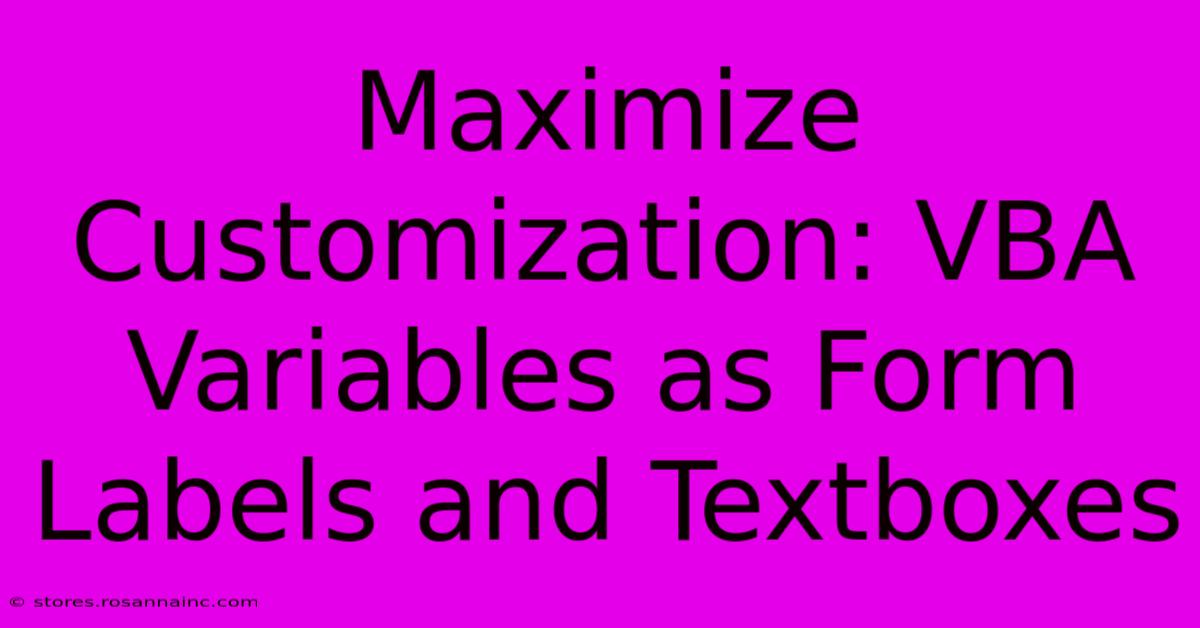Maximize Customization: VBA Variables As Form Labels And Textboxes

Table of Contents
Maximize Customization: VBA Variables as Form Labels and Textboxes
Unlocking the full potential of Microsoft Access forms involves mastering the art of customization. This article dives deep into a powerful technique: dynamically linking VBA variables to form labels and textboxes. This allows for incredibly flexible and responsive forms, adapting to changing data and user input with ease. We'll explore how this method significantly enhances your Access applications, making them more user-friendly and efficient.
Why Dynamic Linking is Essential
Static labels and textboxes on Access forms are limiting. They require manual updates whenever data changes. Imagine needing to display different information based on user selections or database queries. Manually altering labels and textboxes for each scenario is tedious and error-prone. This is where dynamic linking using VBA variables shines. By connecting variables to these form elements, you create forms that automatically reflect data updates, providing a seamless user experience.
Benefits of Using VBA Variables:
- Increased Efficiency: Automatic updates eliminate manual intervention, saving significant time and effort.
- Enhanced User Experience: The form adapts smoothly to changes, providing a more intuitive and responsive interface.
- Reduced Errors: Automation minimizes the risk of human error associated with manual data entry and updates.
- Improved Maintainability: Dynamically linked forms are easier to update and maintain in the long run.
- Greater Flexibility: Adapt your forms to various scenarios and data without extensive code restructuring.
Connecting VBA Variables to Form Controls
The core of this technique involves leveraging the Caption property for labels and the Value property for textboxes. We'll use VBA code to modify these properties based on the values held in your variables.
Step-by-Step Implementation:
-
Declare Variables: In your VBA module, declare the variables you'll be using. For example:
Dim strProductName As String Dim intQuantity As Integer Dim curPrice As Currency -
Assign Values to Variables: Populate these variables with data from your Access database or other sources. This might involve SQL queries or calculations. For instance:
strProductName = DLookup("ProductName", "Products", "ProductID = 1") intQuantity = 10 curPrice = 12.99 -
Link Variables to Form Controls: Access the form's controls using their names and modify their
CaptionorValueproperties. Let's assume you have labels namedlblProductName,lblQuantity, andlblPrice, and textboxes namedtxtProductName,txtQuantity, andtxtPrice. The VBA code would look like this:Me.lblProductName.Caption = strProductName Me.txtProductName.Value = strProductName Me.lblQuantity.Caption = intQuantity Me.txtQuantity.Value = intQuantity Me.lblPrice.Caption = FormatCurrency(curPrice, 2) Me.txtPrice.Value = curPriceNotice the use of
FormatCurrencyto ensure proper formatting of the currency value. -
Event Procedures: To trigger these updates automatically, you can place this code within form events like
On OpenorOn Current. This ensures the form displays the correct information when it opens or when the current record changes.Private Sub Form_Open(Cancel As Integer) 'Code to assign values and update form controls goes here... End Sub -
Error Handling: Always incorporate error handling to manage potential issues such as missing data or database errors.
On Error Resume Nextcan be used cautiously, along with explicit error checks.
Advanced Techniques and Considerations
- Using Arrays: For a large number of controls, using arrays can simplify your code and improve readability.
- Dynamic Control Creation: You can even dynamically create controls at runtime and link them to variables, offering maximum flexibility.
- Data Validation: Couple dynamic linking with input validation to ensure data integrity.
- User Input Handling: Update your variables based on user input in textboxes, triggering subsequent updates in labels or other controls.
Conclusion:
Mastering the use of VBA variables to dynamically update form labels and textboxes in Microsoft Access significantly enhances the power and flexibility of your applications. By implementing these techniques, you create more responsive, user-friendly, and maintainable database systems. Remember to prioritize clear code structure, robust error handling, and thoughtful design to achieve optimal results. This approach transforms your Access forms from static displays into dynamic, data-driven interfaces.

Thank you for visiting our website wich cover about Maximize Customization: VBA Variables As Form Labels And Textboxes. We hope the information provided has been useful to you. Feel free to contact us if you have any questions or need further assistance. See you next time and dont miss to bookmark.
Featured Posts
-
Analog Alchemy The Secrets Of Cn 16 And C 41 Films Unlocking The Perfect Shot
Feb 06, 2025
-
Ferrari Red In D And D A Color That Will Make Your Players Tremble
Feb 06, 2025
-
10 Reasons You Need Dnd Gel Nail Polish In Your Life Indulge In Sheer Nail Perfection
Feb 06, 2025
-
San Diego Workspace Costs Unlocking The True Value Of Flexible Workspaces
Feb 06, 2025
-
Style Sun And Surf Tommy Bahamas Logo Capturing The Aloha Spirit
Feb 06, 2025
